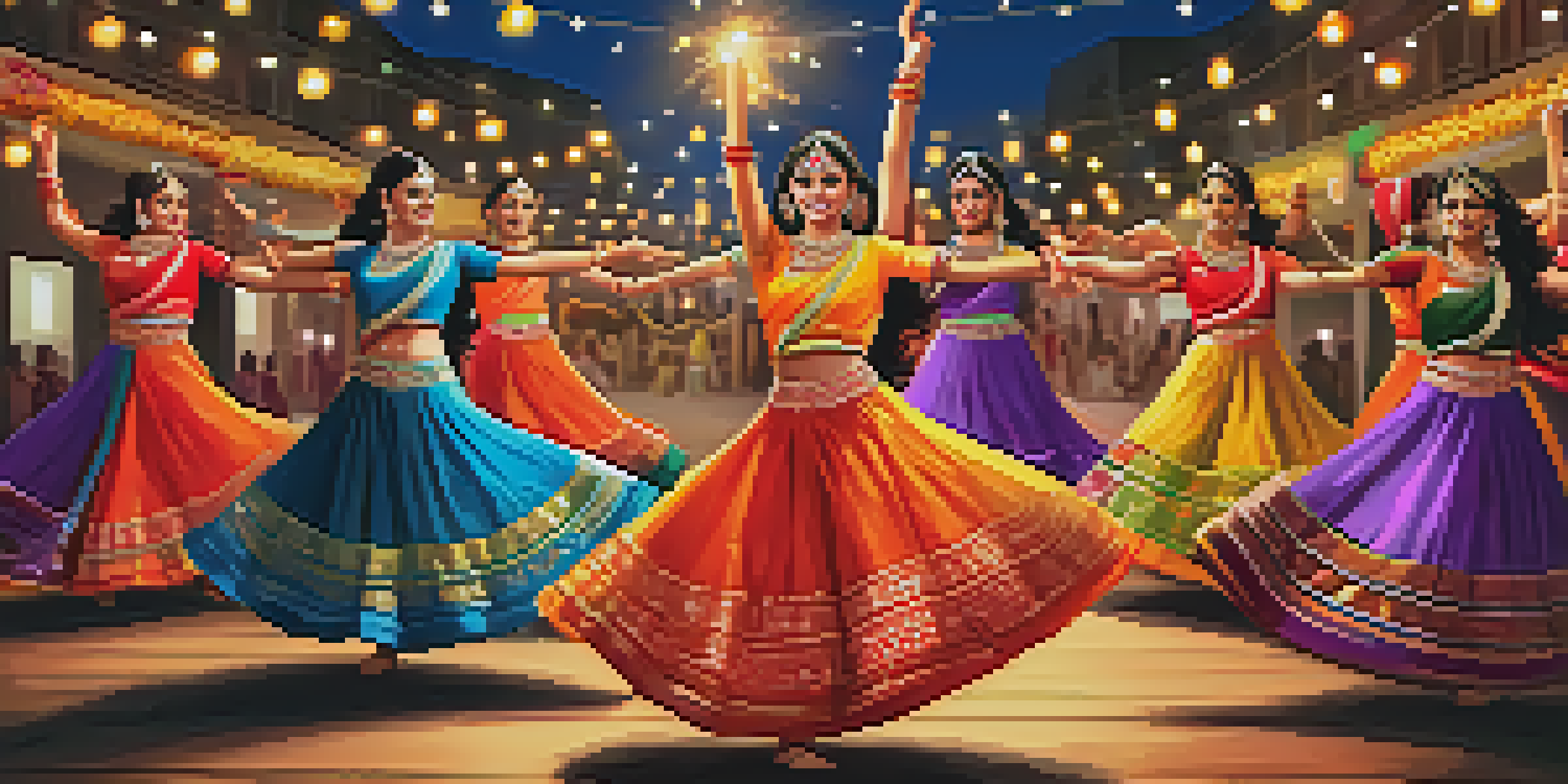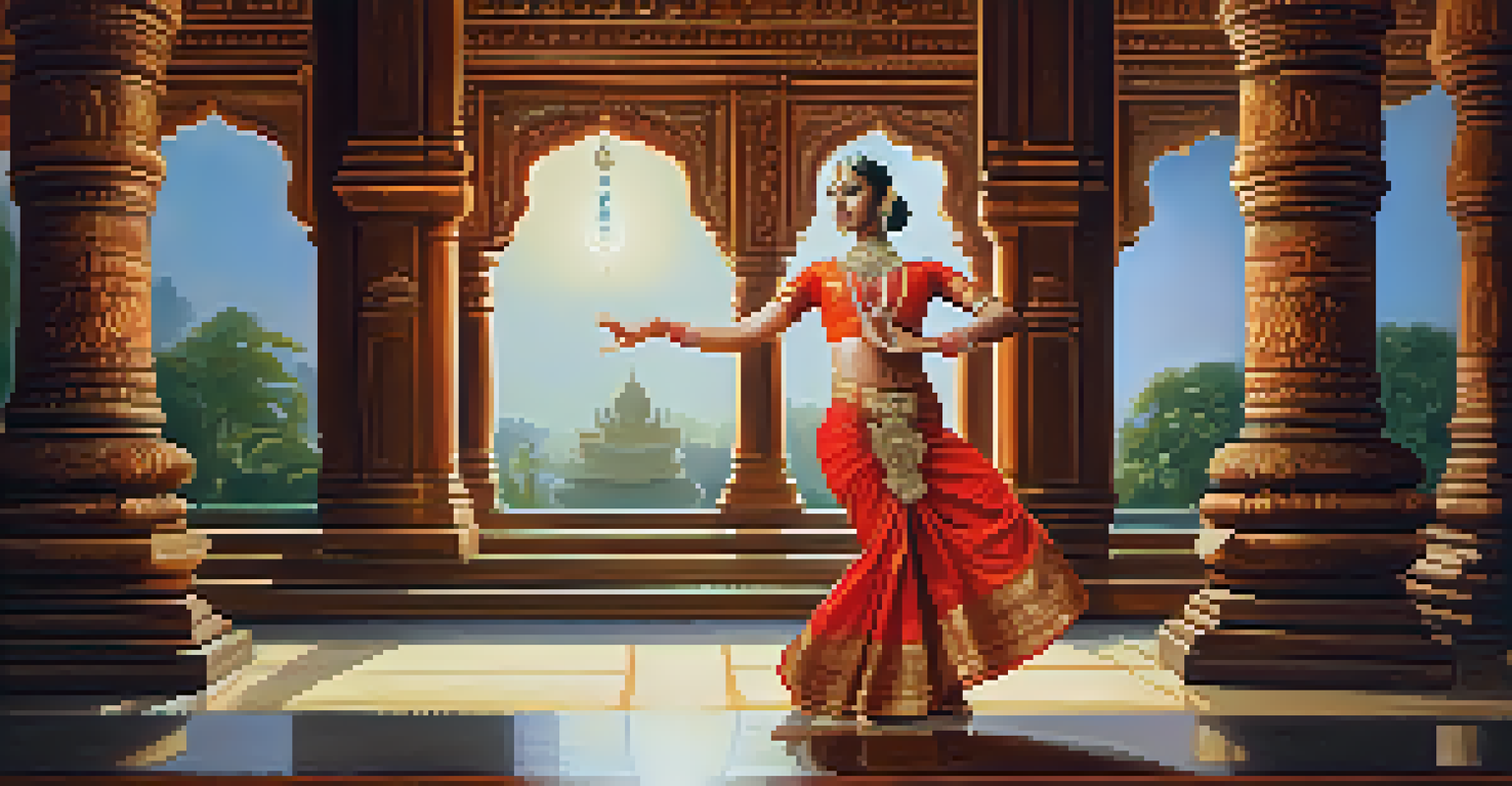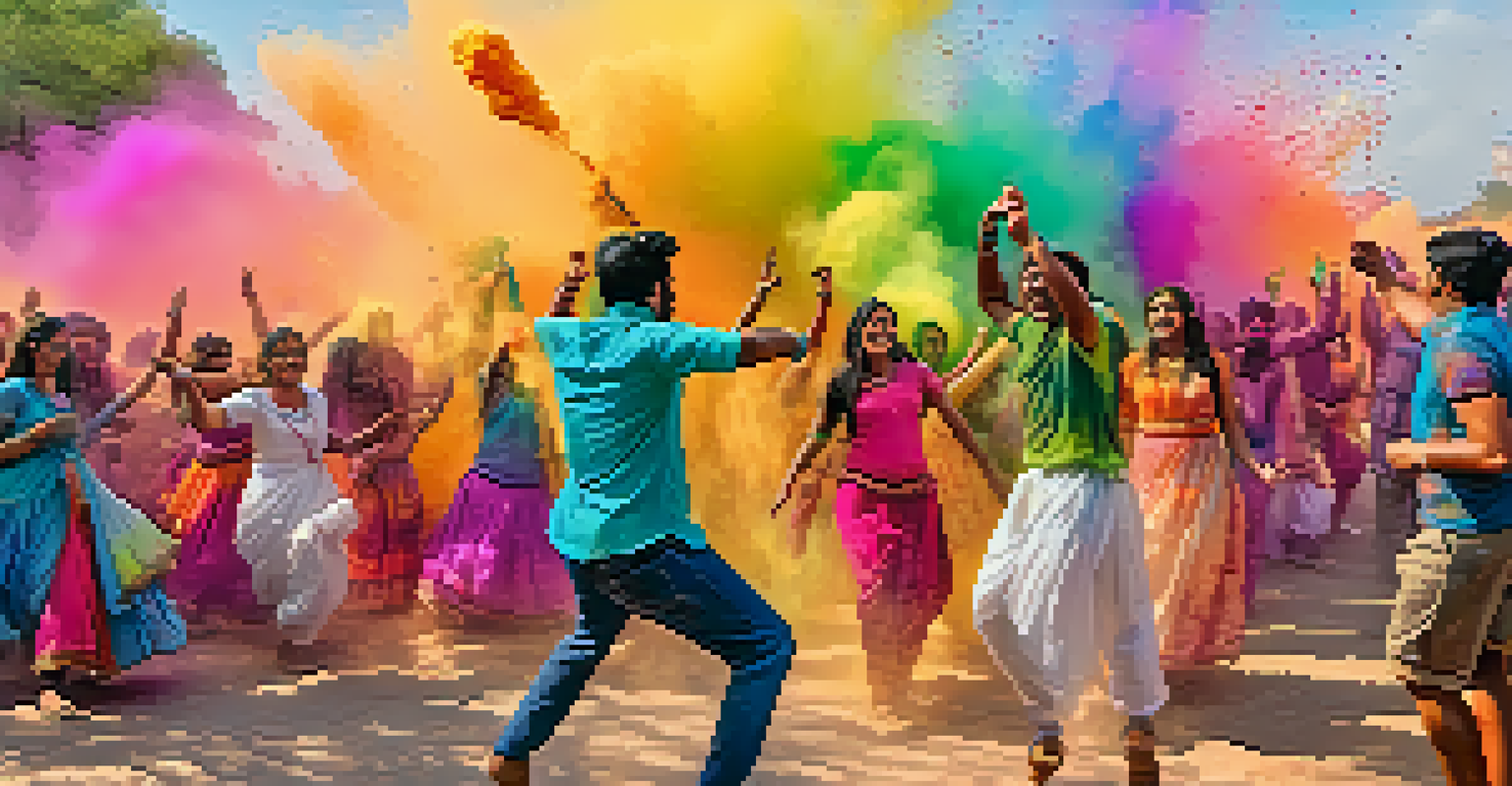Dance Rituals in Hindu Festivals: A Cultural Examination

The Role of Dance in Hindu Culture and Festivals
Dance has long been an integral part of Hindu culture, serving as a medium to express devotion and spirituality. In Hindu festivals, dance rituals bring communities together, allowing participants to connect with each other and the divine. These performances often depict stories from ancient scriptures, making them a living tradition that keeps history alive.
Dance is the hidden language of the soul.
During festivals, various forms of dance, such as Bharatanatyam and Kathak, showcase unique styles that reflect regional diversity. For example, the vibrant Garba dance during Navratri celebrates femininity and the goddess Durga, while the graceful Odissi dance in Odisha narrates tales of Lord Krishna. Each style carries its own significance and adds richness to the festival experience.
Moreover, dance rituals foster a sense of belonging and identity among participants. When people come together to perform, they create bonds that transcend age and social status, reinforcing a collective cultural heritage. This unity is especially poignant during large celebrations, where the energy of group performances elevates the entire atmosphere.
Key Hindu Festivals Featuring Dance Rituals
Several Hindu festivals prominently feature dance as a ritualistic celebration. Diwali, known as the Festival of Lights, often includes traditional dances that symbolize the victory of light over darkness. Communities organize performances that reflect gratitude and joy, enhancing the festive spirit that permeates the air during this time.

Similarly, the festival of Holi, celebrated as the Festival of Colors, incorporates dance as a way to express exuberance and playfulness. Participants engage in lively dances while throwing colored powders, embodying the spirit of joy and togetherness. The rhythmic beats and movements create a vibrant atmosphere where everyone, regardless of age, participates in the revelry.
Dance Unites Communities in Festivals
Hindu festivals use dance rituals to bring people together, fostering a sense of belonging and shared cultural identity.
Other significant festivals, like Pongal in Tamil Nadu, also highlight dance rituals. Folk dances such as Kolattam are performed to honor the harvest and express gratitude to nature. These dances not only celebrate agricultural abundance but also reinforce community ties through a shared cultural experience.
Spiritual Significance of Dance Rituals
Dance in Hindu festivals transcends mere entertainment; it serves a deeper spiritual purpose. Many dance forms are considered a form of worship, allowing performers to communicate with deities and invoke blessings. This spiritual connection is often reflected in the meticulous movements and expressions that dancers embody, making each performance a sacred offering.
The dance is a poem of which each movement is a word.
The act of dancing is believed to purify the mind and body, creating a space for spiritual awakening. For instance, during the festival of Navaratri, devotees engage in Garba and Dandiya Raas as acts of devotion, seeking the goddess's blessings. The rhythmic movements and melodies facilitate a meditative state, enabling individuals to connect with their inner selves and the divine.
Additionally, the choreography often narrates stories from Hindu mythology, enriching the spiritual experience. Dancers embody characters like Lord Rama or the goddess Durga, bringing ancient tales to life. This storytelling aspect fosters a deeper understanding of cultural values and teachings, making the dance ritual both an educational and spiritual journey.
Regional Variations in Dance Rituals
Hindu festivals are celebrated across diverse regions, each showcasing unique dance styles and rituals. For instance, in Kerala, the traditional dance form of Kathakali is performed during temple festivals, characterized by elaborate costumes and facial expressions that tell stories from epics like the Mahabharata. This regional specificity adds layers of meaning and beauty to the celebrations.
In contrast, the folk dances of Gujarat, such as Garba and Dandiya, are vibrant expressions of community spirit during Navratri. These dances are often performed in circles, symbolizing unity and collective joy. The lively music and colorful attire create an electric atmosphere, inviting everyone to join in the celebration, regardless of skill level.
Dance as Spiritual Expression
Many dance forms in Hindu culture serve as a form of worship, allowing performers to connect with deities and explore spirituality.
Furthermore, the distinct styles of dance reflect local customs and traditions, making each festival a unique experience. The interplay of dance and regional culture enriches the overall tapestry of Hindu festivities, showcasing the diversity and inclusivity that are hallmarks of Hinduism.
Dance as a Tool for Social Change
Beyond celebration, dance rituals in Hindu festivals can serve as powerful tools for social change. Many contemporary performers use traditional dance forms to address pressing social issues, raising awareness through storytelling. This makes dance a dynamic platform for dialogue and reflection on topics such as gender equality, environmental concerns, and cultural preservation.
For example, some dance troupes incorporate themes of women's empowerment into their performances during festivals. By highlighting the strength and resilience of female figures from mythology, they inspire audiences to challenge stereotypes and advocate for equality. This modern reinterpretation of traditional dance connects the past with the present, making it relevant to contemporary societal issues.
Additionally, dance festivals often provide a space for marginalized voices to be heard. By showcasing diverse performers, these events promote inclusivity and understanding, fostering a sense of community among different cultural groups. This blend of tradition and activism highlights the transformative power of dance, encouraging positive change within society.
The Influence of Technology on Dance Rituals
In recent years, technology has begun to play a significant role in how dance rituals are experienced and shared during Hindu festivals. Social media platforms allow performers to showcase their dance routines to a global audience, bridging cultural gaps and inspiring others to engage with these traditions. This digital presence not only celebrates the art form but also invites collaboration and innovation.
Live streaming of festival performances has become increasingly popular, allowing people who cannot attend in person to participate virtually. This accessibility fosters a sense of global community, as individuals from different corners of the world can witness and appreciate the beauty of these rituals. The fusion of technology and tradition creates new opportunities for cultural exchange and understanding.
Technology Enhances Dance Accessibility
The integration of technology in dance rituals allows for broader participation and the preservation of traditional art forms in a modern context.
However, the embrace of technology also raises questions about the authenticity of these performances. Some purists argue that the essence of traditional dance may be diluted when adapted for modern platforms. Striking a balance between preserving cultural heritage and embracing contemporary methods is crucial for ensuring that dance rituals continue to thrive in the digital age.
Preserving Dance Rituals for Future Generations
As society evolves, it is essential to preserve the rich tapestry of dance rituals associated with Hindu festivals for future generations. Educational initiatives, such as workshops and dance schools, play a vital role in passing down these traditions. By teaching young dancers the significance of their cultural heritage, we ensure that these rituals remain alive and vibrant.
Community involvement is another key factor in preservation efforts. Local festivals often encourage participation from all age groups, creating an environment where knowledge and skills are shared. This intergenerational exchange not only strengthens community bonds but also instills a sense of pride in cultural identity.

Moreover, documenting dance rituals through film and digital media helps capture the essence of these performances. Creating archives of traditional dances allows future generations to learn from and appreciate their heritage. As we celebrate the past, we also pave the way for a future where these beautiful rituals continue to inspire and unite.